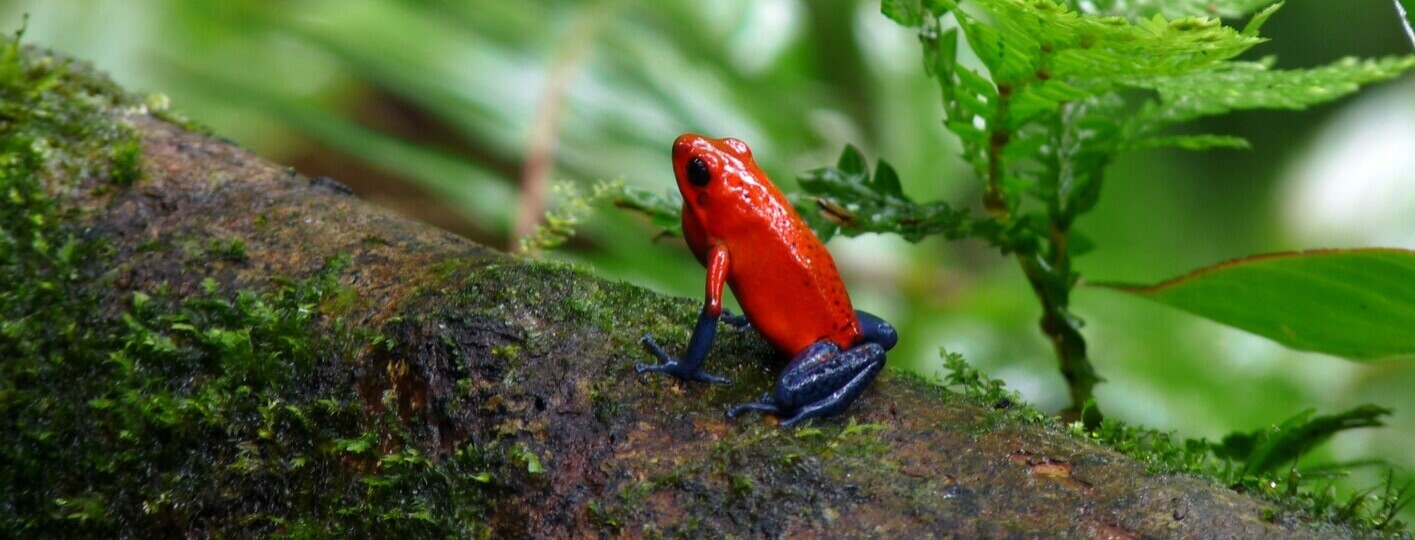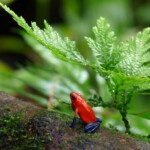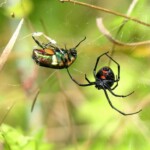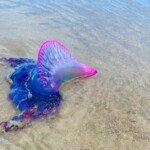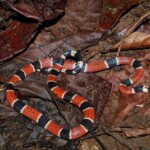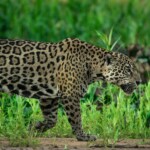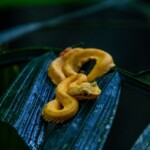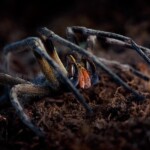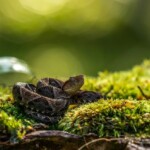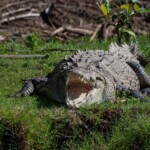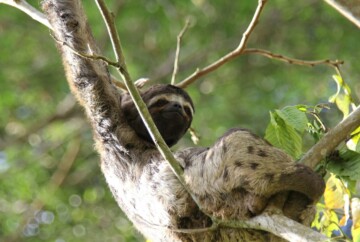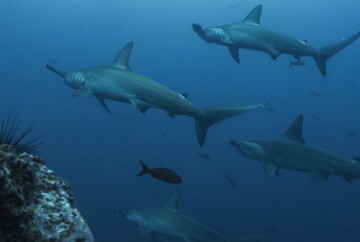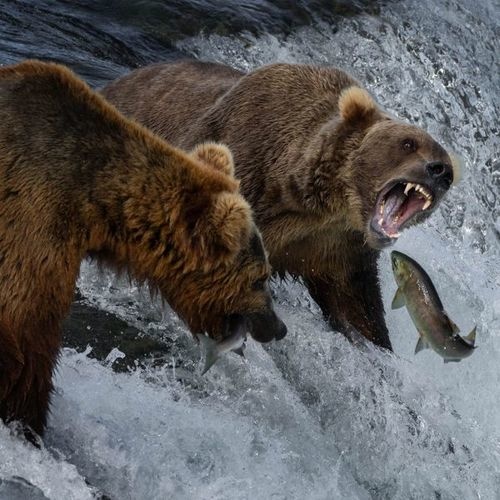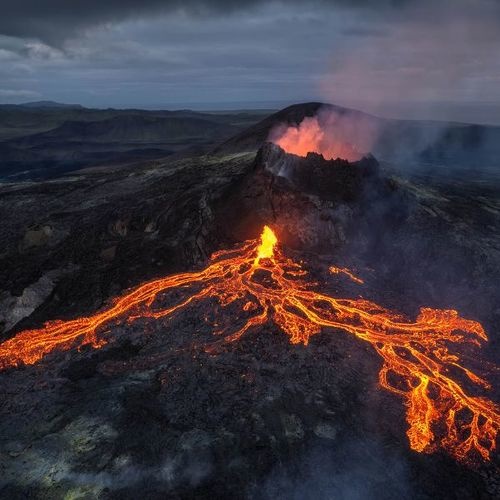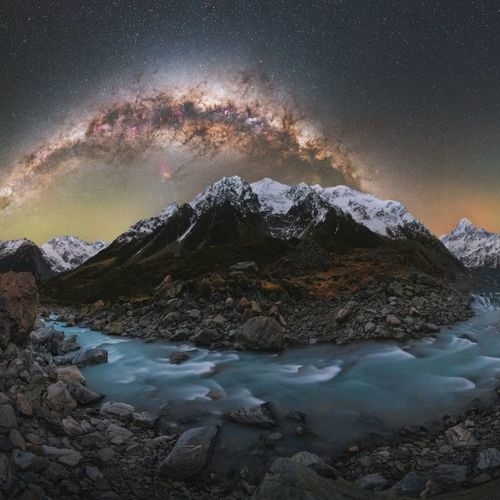Deadly animals in Costa Rica may not be the first thing that comes to mind, but this Central American paradise is as wild as it is beautiful. With its lush rainforests, tropical beaches, and incredible wildlife, the country offers biodiversity like nowhere else, attracting travelers and nature lovers from all over the world. Still, amid all this beauty, there are some creatures you need to be cautious of if you want to enjoy your trip safely.
That said, let me reassure you: in most of the popular tourist areas in Costa Rica, it’s rare to encounter these dangerous species. Still, if you’re heading off the beaten path, taking part in adventure tours of Costa Rica, or exploring more remote regions, it’s important to stay alert. Costa Rica is a safe country to visit, but being able to recognize these creatures quickly will help you stay calm and protect yourself in case you ever come across one.
Before diving into what dangerous animals live in Costa Rica, one important tip: make sure you purchase travel insurance for Costa Rica. None of us ever plans to use it, but unexpected things can happen. I personally rely on Heymondo, and every time I’ve needed help, they’ve been responsive and reliable. That’s why I always recommend them to fellow travelers.
From venomous snakes to large predators, this guide will show you the most dangerous species you might encounter in Costa Rica, where they live, how aggressive they can be, and the best ways to protect yourself. Ready? Let’s get to know these fascinating creatures together!
1. Velvet snake, the most dangerous animal in Costa Rica
The velvet snake, better known locally as the fer-de-lance, has quite the reputation, and for good reason. It’s responsible for the majority of snakebites in Costa Rica, especially in rural and farming areas. Its notoriety is well-deserved, making it the deadliest animal in Costa Rica.
This snake can grow close to 6 feet long and is usually brown with dark patterns that camouflage perfectly in the vegetation. You’ll most often find it in humid tropical forests, rural regions, and farmlands, though it sometimes shows up near houses (particularly after rain), looking for frogs, rodents, or simply a dry place to hide. Popular areas where sightings are more common include Tortuguero, La Fortuna, and the Osa Peninsula.
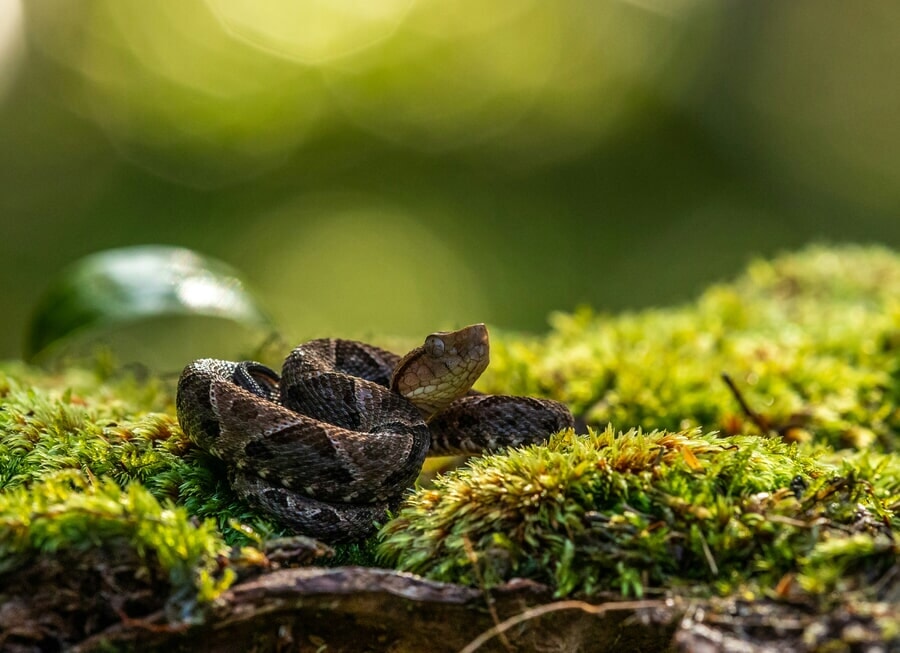
1. Velvet snake, the most dangerous animal in Costa Rica
While the velvet snake is mainly nocturnal and won’t attack without reason, it is extremely sensitive and territorial. If it feels even slightly threatened, it will strike, and because it often moves close to the ground, the chances of an unexpected encounter are higher.
Its venom is incredibly toxic, capable of causing severe pain and, in the worst cases, death if treatment is delayed. But don’t panic: medical centers across Costa Rica are well-prepared with antivenom and are highly experienced in handling bites.
- Where it’s found: Tropical forests, rural and farming areas, sometimes even near homes. Most common in the Osa Peninsula, Northern Caribbean (Tortuguero), and Northern Zone (La Fortuna, Sarapiquí).
- Aggressiveness: High if threatened; may occasionally attack without provocation.
- Fatality rate: High. Its venom is very dangerous but treatable with readily available antivenom.
- Real risk for tourists: Low in urban areas and on marked trails; moderate in rural areas or on unguided hikes.
- How to reduce risk: Wear long pants and sturdy boots when walking through countryside areas, avoid dense vegetation at night, and always check before sitting on or leaning against logs or rocks.
2. Banana spider, another deadly animal in Costa Rica
The banana spider, also known as the Brazilian wandering spider, is another one of the most deadly animals in Costa Rica. It gets its name from its habit of hiding inside bunches of bananas and plantains, although you may also see it moving along the ground.
These spiders thrive in warm, humid places with thick vegetation, which makes Costa Rica an ideal home. They’re especially common in agricultural regions with banana, plantain, and cacao plantations. You might also come across them in tropical forests such as Corcovado, the Osa Peninsula, Tortuguero, and the Southern Caribbean region, including Puerto Viejo.
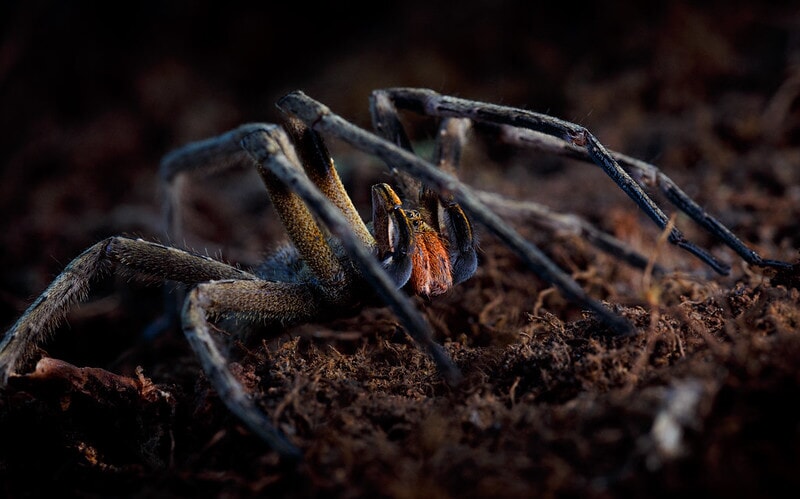
2. Banana spider, another deadly animal in Costa Rica
At first glance, they look somewhat like tarantulas, with hairy legs, a prominent thorax, and sharp front fangs. Personally, they’re not the kind of creatures I’d like to meet up close. Unlike many spiders that flee when disturbed, banana spiders tend to stand their ground and may become aggressive if cornered or surprised.
Their bite is extremely painful, and the venom directly attacks the nervous system. Symptoms can include intense sweating, rapid heartbeat, nausea, vomiting, and in severe cases, paralysis or even death. Fortunately, with proper medical treatment—which is available across Costa Rica—fatalities are extremely rare.
- Where it’s found: Tropical forests, banana and cacao plantations, humid jungles, and rural zones.
- Aggressiveness: High if threatened; tends not to retreat.
- Fatality rate: High. The venom is extremely toxic but treatable with medical care.
- Real risk for tourists: Low. You’re unlikely to encounter one unless you’re in agricultural areas or handling fruit.
- How to reduce risk: Always shake out shoes and clothing before putting them on, avoid sticking your hands into dark spaces, and if staying in rural areas, keep your luggage zipped up and your shoes covered.
3. Tree vipers, one of the most venomous animals in Costa Rica
Tree vipers are among the most famous and most dangerous animals of Costa Rica. These snakes are highly venomous and at the same time strikingly beautiful, with colors that range from green to yellow, brown, and even red depending on the species. Out of the many that exist, three in particular are the most recognized.
The first is the bocaracá, also called the eyelash viper, which gets its name from the curious scale-like “lashes” above its eyes. It is usually found in the misty cloud forests of Costa Rica but can also be seen resting on low tree branches near rivers, creeks, and ravines. Then there is the lora viper, which prefers more elevated and humid regions, especially in the Monteverde Cloud Forest and throughout the Talamanca Mountain Range. Finally, the South Pacific eyelash viper has a clear favorite spot, and that is the southern region of the country, particularly the Osa Peninsula.
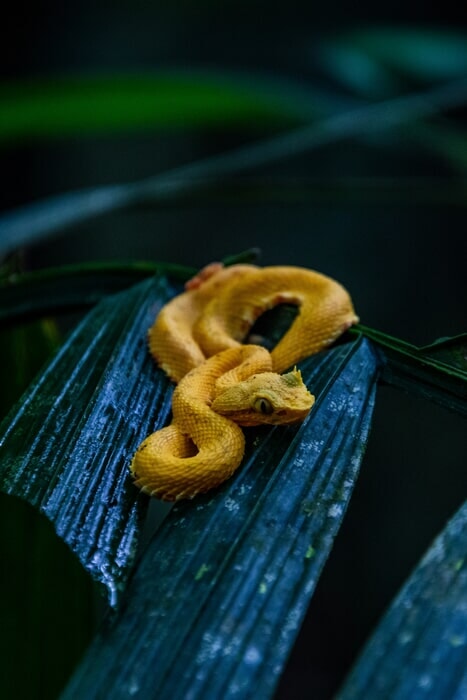
3. Tree vipers, one of the most venomous animals in Costa Rica
Although these snakes are venomous, they are not considered aggressive by nature. They will only strike if they feel threatened or if someone accidentally disturbs them. Even then, their bite, while very painful and dangerous, is rarely fatal as long as it is treated quickly.
Another important detail is that tree vipers are nocturnal. They tend to be most active in the late evening and at night. During the day, they usually stay perfectly still, camouflaged among the leaves, which greatly lowers the chances of crossing paths with one during daytime hikes.
- Where it’s found: Tropical forests, cloud forests, humid mountain regions.
- Aggression: Generally, not aggressive, but they will bite if threatened or touched accidentally.
- Fatality rate: Medium. Their venom can cause serious tissue damage but is not usually fatal with medical treatment.
- Real risk for tourists: More likely to be spotted on guided night walks or if venturing off marked trails.
- How to reduce risk: Avoid touching branches or tree trunks without checking first, walk with a guide in the jungle, and always carry a flashlight if you head out at night.
4. Dart frog, another deadly animal in Costa Rica
Dart frogs are among the most dangerous amphibians in the world, often admired for their dazzling colors, but they also rank as some of the deadliest animals in Costa Rica. Their tiny size can be deceiving. Although they may look charming, these little frogs are armed with toxins powerful enough to cause serious harm. The reassuring part is that while Costa Rica is home to seven species of dart frogs, the deadliest of them all, the Colombian golden frog, does not live here.
One of the most iconic species you will encounter is the so-called “blue jeans frog.” This frog only measures about 0.8 inches, but it stands out with its vivid red body and striking blue legs, which look like it is wearing a pair of jeans. Its bright appearance is not just for show. It serves as a natural warning sign of its strong toxicity. In fact, just one of these frogs carries enough poison to potentially kill more than 15 human adults.
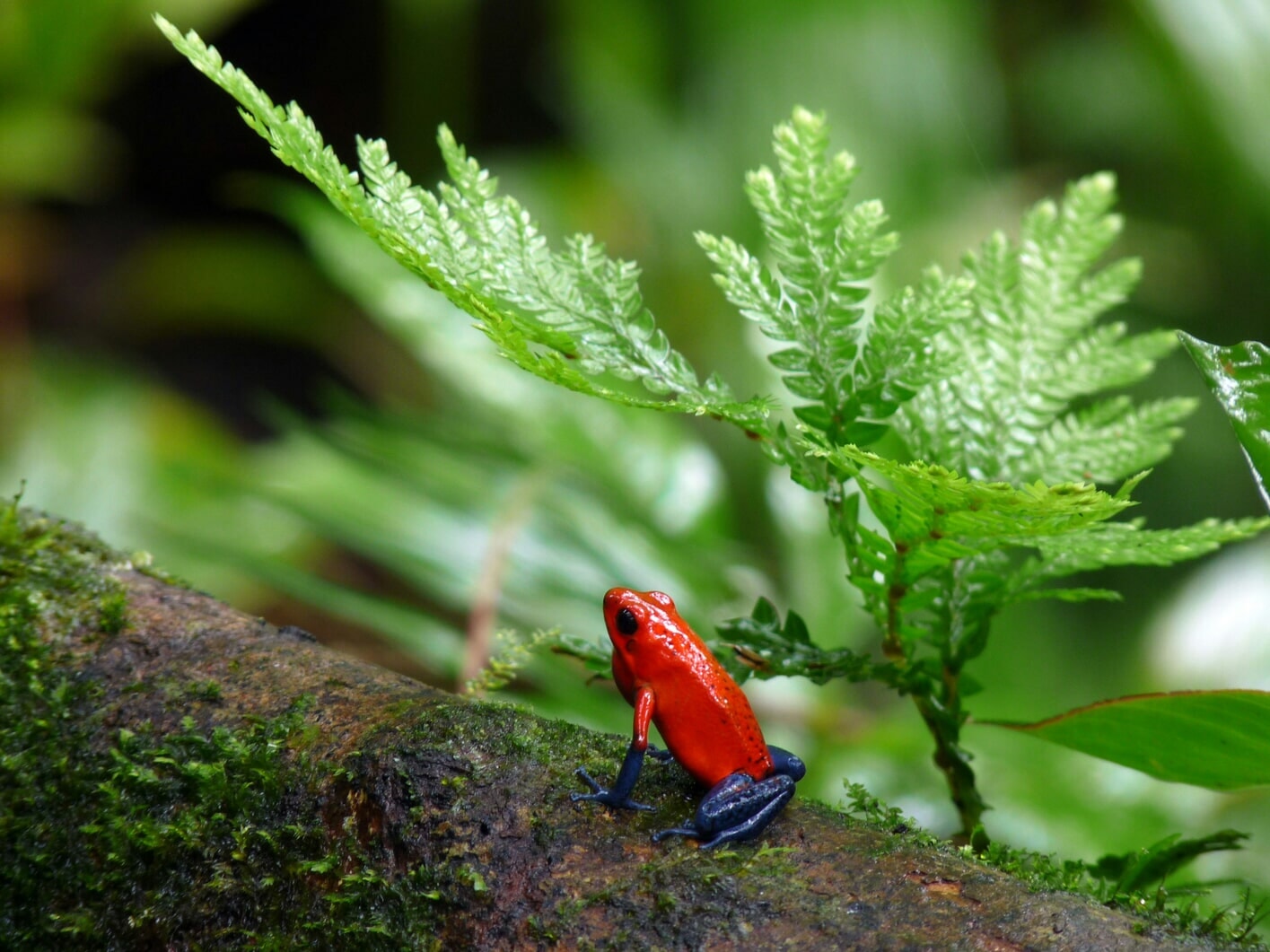
4. Dart frog, another deadly animal in Costa Rica
Dart frogs usually live among the leaf litter on the floor of humid tropical forests, though they occasionally climb to lower branches and plants. They are often spotted in regions such as Tortuguero, the Osa Peninsula, and parts of the Caribbean coast. Observed from a safe distance, they are completely harmless and even fascinating to watch. The danger only arises if you touch them directly.
Unlike many dangerous animals, dart frogs are not aggressive at all and will never attack humans. The real threat lies in the toxins secreted through their skin. Interestingly, they do not create these toxins on their own. Instead, they absorb them from their specialized diet of ants and small toxic insects. Contact with their skin can cause irritation, numbness, nausea, vomiting, and in severe cases, even death.
- Where it’s found: Humid tropical forests.
- Aggression: Non-aggressive; they do not attack humans.
- Fatality rate: Varies by species. Some can cause mild irritation while others can be deadly.
- Real risk for tourists: Very low, since they are only dangerous if handled directly.
- How to reduce risk: Never touch wild frogs. Admire them from a safe distance and respect them in their natural environment.
5. American crocodile, one of the largest and deadliest animals of Costa Rica
The American crocodile is, without a doubt, one of the most impressive animals in Costa Rica. There are plenty of them throughout the country, but spotting them is not always easy. Their camouflage is so effective that their rough heads, half-submerged in the murky water, can easily be mistaken for pieces of driftwood.
One of the best-known places to see crocodiles is the Tárcoles River, near Carara National Park, where they gather in large numbers. Beyond this, they are typically found in the tropical lowlands of Costa Rica. Their favorite habitats are riverbanks, mangroves, lagoons, and coastal areas with warm waters. They thrive in muddy swamps and lightly wooded zones that provide both shelter and abundant water sources.
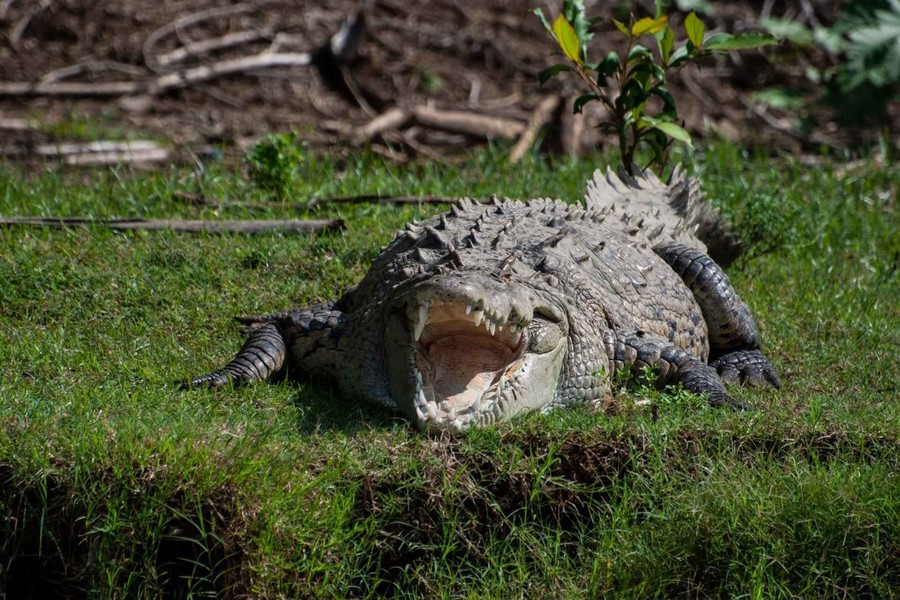
5. American crocodile, one of the largest and deadliest animals of Costa Rica
Although crocodiles generally avoid humans, they are still among the most dangerous animals in Costa Rica when provoked or if their territory is disturbed. While such situations are rare, accidents can happen when people swim in waters known to be crocodile habitats or venture too close to the shoreline. The risk is particularly high after sunset, since this is when they are most active. With their massive size and strength, a single bite can be deadly. To put it in perspective, some of these giants grow longer than 16 feet.
Besides crocodiles, Costa Rica is also home to the spectacled caiman. This species is considerably smaller and less dangerous, but caution is still advised when visiting rivers, lagoons, or wetlands where they live.
- Where it’s found: Rivers, mangroves, estuaries, lagoons, and coastal areas.
- Aggression: Territorial, will attack if it feels invaded or during hunting.
- Fatality rate: High, thanks to its extremely powerful bite.
- Real risk for tourists: Low. Sightings are frequent, but attacks are rare if safety guidelines are respected.
- How to reduce risk: Never swim in rivers or mangroves without a local guide, do not feed or provoke crocodiles, and always keep a safe distance.
6. Jaguars, one of the most dangerous animals in the Costa Rican rainforest
The jaguar is another dangerous rainforest animal in Costa Rica, and it holds the title of being the largest feline in the Americas. This solitary and nocturnal hunter is fiercely territorial and has an incredibly strong bite, powerful enough to crush turtle shells and even penetrate the skulls of its prey. Combined with its speed and stealth, the jaguar is a predator that inspires both awe and respect in the depths of the jungle.
Although considered critically endangered, jaguars still inhabit Costa Rica’s rainforests. You may encounter them in remote areas of Corcovado National Park, Tortuguero National Park, the Golfo Dulce Forest Reserve, the Talamanca Mountain Range, and some parts of the Southern Caribbean. They are unique among big cats in that they are excellent swimmers, often seen crossing rivers or ambushing prey in the water, which sets them apart from most other feline species.
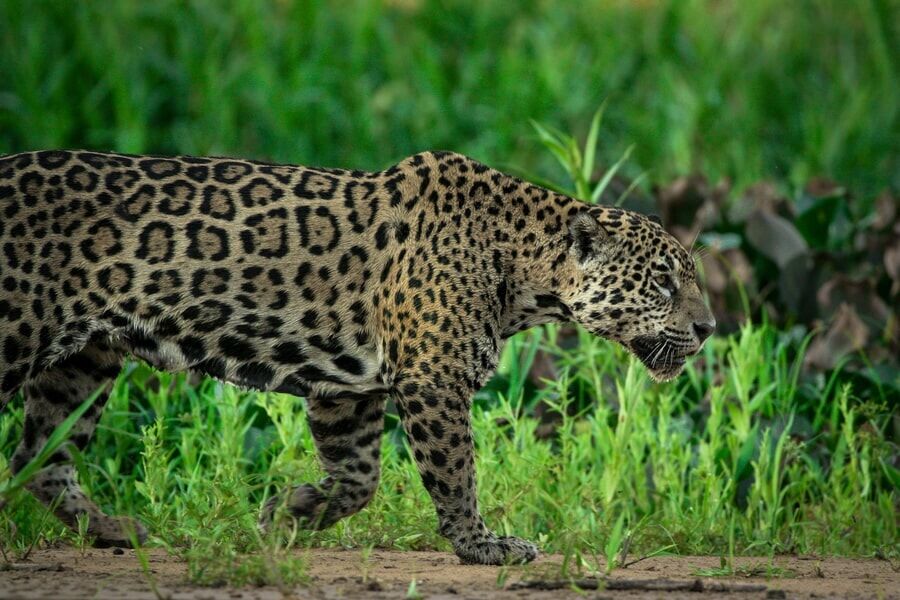
6. Jaguars, one of the most dangerous animals in the Costa Rican rainforest
On rare occasions, visitors may also spot melanistic jaguars, better known as black panthers. This genetic variation occurs in roughly 6 percent of the global jaguar population, and sightings have been reported in Costa Rica as well.
Despite their hunting prowess, jaguars do not pose a significant threat to humans. The population in Costa Rica has declined drastically, leaving only a few scattered individuals across vast, unexplored territories. Encounters with people are extremely uncommon, and when they do occur, they rarely end in conflict. Jaguars generally avoid human contact whenever possible.
It is also worth mentioning that the jaguar is not the only large feline in Costa Rica. Pumas are present too, though they are just as elusive and pose virtually no danger to travelers.
- Where it’s found: Remote rainforests and less-visited protected areas.
- Aggression: Avoids humans, will only defend itself if threatened.
- Fatality rate: Medium. A potential attack could be fatal, but this is extremely rare.
- Real risk for tourists: Very low, since encounters are almost unheard of on tourist trails.
- How to reduce risk: Do not explore deep jungle areas without a guide, and make some noise while walking to reduce the chance of surprising one unexpectedly.
7. Bull shark, one of the most dangerous ocean animals in Costa Rica
When it comes to the most dangerous animals in Costa Rica, the bull shark definitely deserves a spot on the list. Known as one of the most territorial shark species, it stands out for its muscular build, intimidating presence, and impressive size, often reaching about 10 feet in length.
Bull sharks are commonly found in the warm waters along Costa Rica’s Pacific coast. One of the most famous places to see them is the Bat Islands, a world-class destination where divers can observe bull sharks in their natural environment without artificial feeding. If you plan to dive in Guanacaste, keep in mind that the currents in this area are strong, so it is recommended only for experienced divers. That said, witnessing these powerful creatures up close in their natural habitat is truly unforgettable.
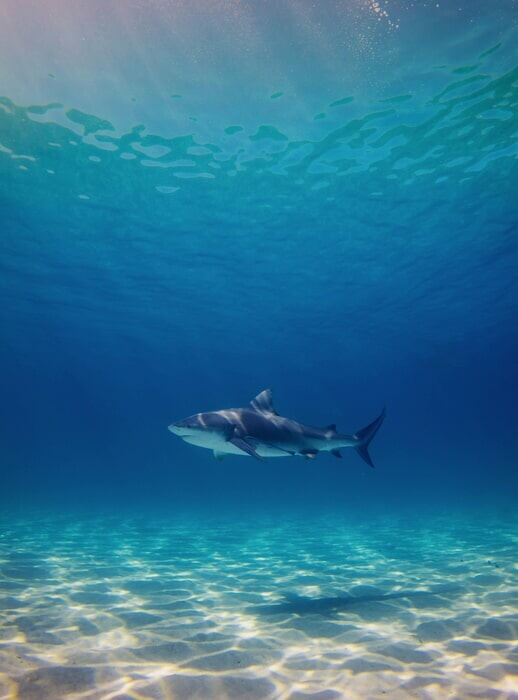
7. Bull shark, one of the most dangerous ocean animals in Costa Rica
Interestingly, bull sharks are not limited to the ocean. Some have even been spotted in the canals of Tortuguero National Park. This is because bull sharks are one of the few shark species capable of living in both saltwater and freshwater, allowing them to travel upriver.
Although bull sharks are considered aggressive, diving encounters are generally safe and awe-inspiring. Actual attacks on humans are very rare. The potential danger arises when they venture closer to shore, as they may confuse swimmers for prey. Even then, such incidents are extremely uncommon.
- Where it’s found: Mostly along the Pacific coast, occasionally in the canals of Tortuguero.
- Aggression: Potentially aggressive, especially if provoked or stimulated by sudden movements or blood.
- Fatality rate: High. Their bite is extremely powerful, though attacks are rare.
- Real risk for tourists: Low. Risks are minimal for divers with guides, slightly higher for swimmers in coastal rivers or estuaries.
- How to reduce risk: Always dive with professional instructors, and avoid swimming in estuaries or river mouths.
8. True coral snake, another dangerous jungle animal in Costa Rica
Another venomous animal in Costa Rica is the true coral snake, instantly recognizable for its striking red, yellow, and black banded pattern. It is often described as having one of the deadliest venoms in the world. Its colors are so iconic that even non-venomous snakes imitate them to trick predators into keeping their distance.
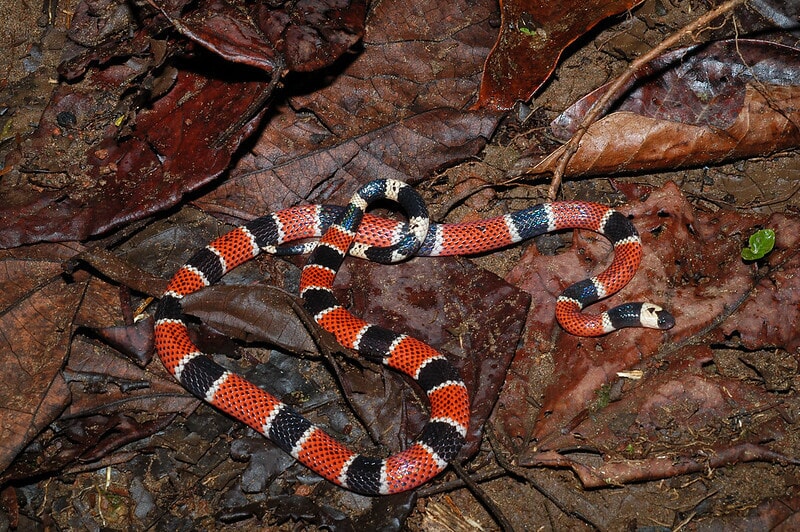
8. True coral snake, another dangerous jungle animal in Costa Rica
Despite its fearsome reputation, the coral snake is a relatively small and shy animal. It prefers to live hidden in the leaf litter of humid jungles and dry forests, particularly in the Caribbean region and parts of the South Pacific. Because of its secretive nature, it is not easy to spot during the day, and it is unlikely to approach humans unless disturbed. In fact, these snakes are not aggressive at all and will usually only bite if they feel trapped or directly threatened.
Still, if a bite occurs, the danger is very real. Coral snake venom is powerful enough to paralyze the respiratory muscles, which can quickly become fatal without medical treatment. Fortunately, bites are extremely rare, and Costa Rica has effective antivenoms that work well if medical help is sought promptly.
- Where it’s found: Humid jungles and dry forests.
- Aggression: Very low, bites only if cornered or provoked.
- Fatality rate: High. Its venom is extremely toxic, but antivenom is available.
- Real risk for tourists: Very rare. They usually stay hidden and avoid human contact.
- How to reduce risk: Watch your step, and avoid putting your hands or feet into piles of leaves or logs without checking first.
9. Portuguese man o’ war, another dangerous marine animal in Costa Rica
The Portuguese man o’ war is not a single animal in the traditional sense but rather a fascinating colony of organisms that function together as one. At first glance, it looks a lot like a jellyfish, though some people say that when it floats on the surface, it resembles an old Portuguese sailing ship, which is where it gets its name.
If you spend time on Costa Rica’s beaches, you may come across these strange creatures. They are present on both the Pacific and Caribbean coasts, most often during the summer months and especially when the tides and currents carry them closer to shore.
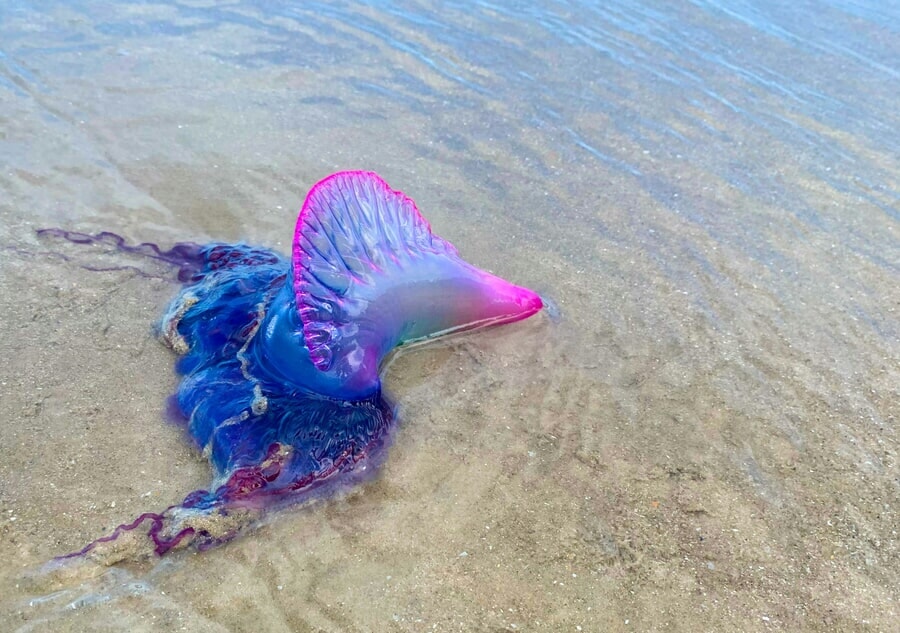
9. Portuguese man o’ war, another dangerous marine animal in Costa Rica
Remember that the Portuguese man o’ war does not attack. However, accidental contact with its tentacles can be very painful. Depending on a person’s sensitivity, the sting may also trigger serious cardiovascular or respiratory complications, since the toxins can affect the heart and lungs. If you’re planning to snorkel in Costa Rica, you should be particularly careful because the tentacles are difficult to spot and can stretch out underwater or even lie buried in the sand. They can reach lengths of up to 33 feet.
The venom from a sting can cause intense pain, blistering, swelling, skin irritation, and even systemic allergic reactions. While some people experience symptoms similar to a jellyfish sting, others can face severe or even life-threatening complications. If you are stung, it is crucial to seek medical help right away. Do not rub or scratch the affected area. Instead, carefully remove any tentacles using gloves, rinse the skin with seawater, and apply vinegar to help relieve the pain until you receive professional treatment.
- Where it’s found: Pacific and Caribbean coastal waters, most common during high tide and summer currents.
- Aggression: Does not actively attack; stings happen by accidental contact.
- Fatality rate: Medium. Most cases involve painful allergic reactions, but in rare situations, complications with the heart or lungs can be fatal.
- Real risk for tourists: Moderate during certain seasons, especially for beachgoers and snorkelers.
- How to reduce risk: Never touch or step on jellyfish-like organisms washed onto the beach.
10. Black widow spider, one of the most famous dangerous animals in Costa Rica
Almost everyone has heard of the black widow spider. This small but infamous arachnid is instantly recognized by the bright red hourglass marking on its abdomen. Because of its reputation worldwide, it naturally earns a place on the list of the most dangerous animals in Costa Rica.
Despite the fearsome legends that surround it, the truth is that black widows are among the most widespread spiders on the planet. While their venom is potent and bites can cause unpleasant symptoms such as pain, muscle cramps, or nausea, they are very rarely fatal. Antivenom treatments are highly effective, and only in exceptional cases do bites lead to serious medical complications.
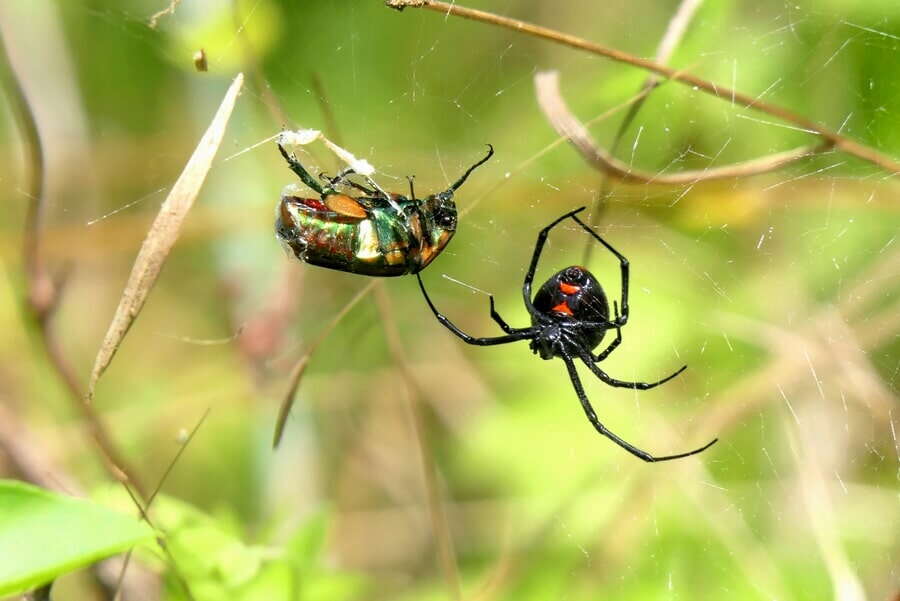
10. Black widow spider, one of the most famous dangerous animals in Costa Rica
In Costa Rica, black widows can be found in many regions, from rural areas to both dry and humid forests. They have been spotted in well-known natural attractions such as Rincón de la Vieja National Park, one of the most popular national parks in Costa Rica. They can also appear close to human settlements, hiding in quiet corners, firewood piles, under rocks, or even near homes.
The good news is that black widows are not aggressive by nature. They will only bite if they feel directly threatened or if they are accidentally touched, so as long as you avoid disturbing them, they will not pose a danger to you.
- Where it’s found: Rural areas, as well as dry and humid forests.
- Aggression: Low, will only bite in self-defense.
- Fatality rate: Medium. Their venom is strong, but treatment is widely available and effective.
- Real risk for tourists: Low. Encounters in popular tourist areas are uncommon.
- How to reduce risk: Shake out clothing and shoes before use, and avoid placing hands in dark, hidden spots.
10+1. Mosquitoes: the deadliest animal in Costa Rica that you should protect yourself from
If someone asks what the most dangerous animal in Costa Rica is, the answer might surprise you. It isn’t a jaguar, a crocodile, or even a venomous snake. The real threat comes from mosquitoes. At first glance, they don’t look like much; tiny little insects we usually brush away without a second thought. But in Costa Rica, these small creatures pose the greatest risk to travelers because they feed on blood and can transmit serious diseases like dengue, Zika, and chikungunya.
Mosquitoes thrive in warm and humid conditions, which means you’ll find them in the jungle, in rural regions, and even in cities, wherever there is stagnant water. If you plan to visit Costa Rica during the rainy season, it’s especially important to stay alert.
Even though mosquitoes seem harmless, the illnesses they spread can make you very sick. While there are treatments to help with the symptoms, there are currently no medications that can cure these viruses directly. Your body has to fight them off on its own.
In certain cases, these diseases can lead to serious complications and, in rare situations, even be fatal. This is one of the key reasons why having travel insurance for Costa Rica is so important. Realistically, mosquitoes are far more likely to cause problems for visitors than any of the other animals we’ve mentioned on this list. If you notice warning signs such as fever, severe headache, or joint pain during your trip or after returning home, don’t hesitate to seek medical attention immediately.
The best defense is prevention, and that starts with a smart packing list for Costa Rica. Always bring mosquito repellent with you. Long, loose, light-colored clothing is also highly recommended.
- Where it’s found: Jungles, rural areas, and even urban spaces with stagnant water.
- Aggression: They do not attack out of hostility; they sting simply to feed.
- Fatality rate: Indirectly high, since they can transmit serious diseases.
- Real risk for tourists: Very frequent, as mosquitoes are common across the country.
- How to reduce risk: Use insect repellent and mosquito nets, avoid stagnant water, and wear long, loose, light-colored clothing, especially around sunrise and sunset when mosquitoes are most active.
And that wraps up the list of the deadliest animals in Costa Rica. As you can see, the country’s biodiversity is both breathtaking and incredibly diverse. While some creatures can pose real risks (mosquitoes being the main one), serious incidents involving travelers are actually very rare.
If you’re wondering how to avoid dangerous animals in Costa Rica, the good news is that it’s easier than you might think. With a little awareness, by listening to local guides, and by taking some simple precautions like applying repellent, wearing the right clothing, and getting good travel insurance, you can explore this paradise safely and with peace of mind.
If you have any questions or would like to share your personal experience with any of Costa Rica’s venomous animals, drop a comment below. I’d love to hear your stories.
Pura Vida!
